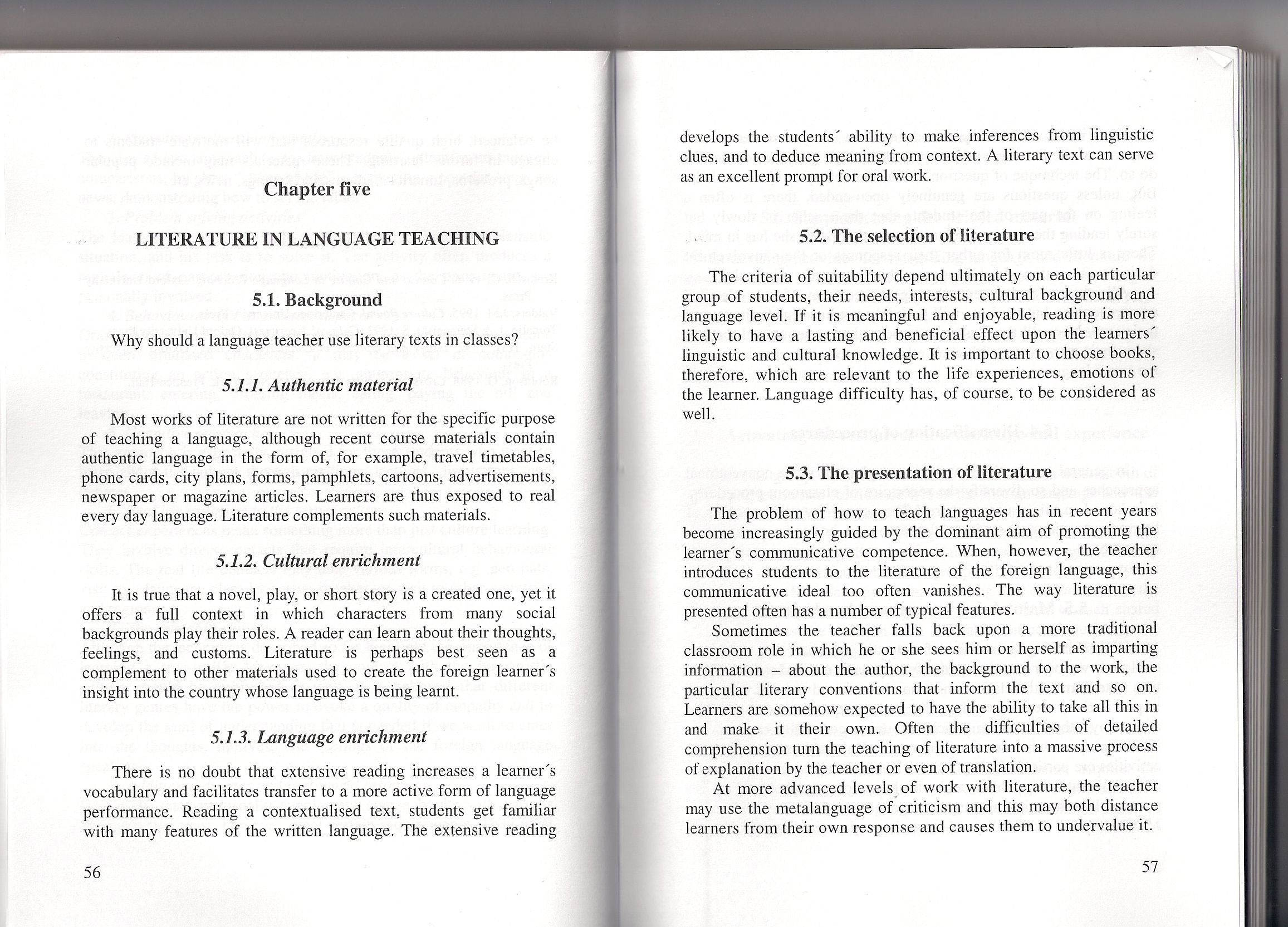skanowanie0028 (21)

Chapter five
LITERATURĘ IN LANGUAGE TEACHING
5.1. Background
Why should a language teacher use literary texts in classes?
5.1.1. Authentic materiał
Most works of literaturę are not written for the specific purpose of teaching a language, although recent course materials contain authentic language in the form of, for example, travel timetables, phone cards, city plans, forms, pamphlets, cartoons, advertisements, newspaper or magazine articles. Leamers are thus exposed to real every day language. Literaturę complements such materials.
5.1.2. Cultural enrichment
It is true that a novel, play, or short story is a created one, yet it offers a fuli context in which characters from many social backgrounds play their roles. A reader can leam about their thoughts, feelings, and customs. Literaturę is perhaps best seen as a complement to other materials used to create the foreign learner's insight into the country whose language is being learnt.
5.1.3. Language enrichment
There is no doubt that extensive reading increases a learneris vocabulary and facilitates transfer to a morę active form of language performance. Reading a contextualised text, students get familiar with many features of the written language. The extensive reading develops the students' ability to make inferences from linguistic clues, and to deduce meaning from context. A literary text can serve as an excellent prompt for orał work.
5.2. The selection of literaturę
The eriteria of suitability depend ultimately on each partieular group of students, their needs, interests, cultural background and language level. If it is meaningful and enjoyable, reading is morę likely to have a lasting and beneficial effect upon the learners' linguistic and cultural knowledge. It is important to choose books, therefore, which are relevant to the life experiences, emotions of the learner. Language difficulty has, of course, to be considered as well.
5.3. The presentation of literaturę
The problem of ho w to teach languages has in recent years become increasingly guided by the dominant aim of promoting the learner"s communicative competence. When, however, the teacher introduces students to the literaturę of the foreign language, this communicative ideał too often vanishes. The way literaturę is presented often has a number of typical features.
Sometimes the teacher falls back upon a morę traditional classroom role in which he or she sees him or herself as imparting information - about the author, the background to the work, the partieular literary conventions that inform the text and so on. Learners are somehow expected to have the ability to take all this in and make it their own. Often the difficulties of detailed comprehension tum the teaching of literaturę into a massive process of explanation by the teacher or even of translation.
At morę advanced levelsvof work with literaturę, the teacher may use the metalanguage of criticism and this may both distance learners from their own response and causes them to undervalue it.
57
Wyszukiwarka
Podobne podstrony:
skanowanie0073 (3) Ur, P. 1996 A Course in Language Teaching: Practice and Theory CUP Wijk, A. 1966
77976 skanowanie0031 (16) Chapter sixLANGUAGE TESTING6.1. Background Language tests in generał fulfi
skanowanie0037 (13) Cohen, A.D. 1989. Second Language Testing. In: Teaching English as a Second or F
55553 skanowanie0004 (121) Chapter five Literaturę in Language
skanowanie0034 (21) f f”1 - -" i. ■ in^Mjiiiir"‘‘,AM‘^M,MT -mb?^ ^ Ci i
Dydaktyka 3 It was called Classical Method sińce it was first used in the teaching of the classical
Eyelet Template (21) Smali cards In this chapter, I will showyou some examples of smali cards. They
więcej podobnych podstron